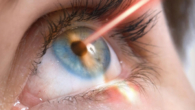
What is a tension headache and how to deal with it
0
If if you work a lot while sitting and like coffee, most likely you cannot avoid this pain.
What is a tension headache
A tension headache is the most common type of headache. According to American statistics, two out of every three adult residents of the United States regularly suffer from it.
It manifests itself as an aching sensation in the forehead and behind the eyes, sometimes affecting the temple, the back of the head, and even extending into the shoulders. Doctors describe it like this: as if a wide and too tight hoop was put on the head. Trying to get rid of discomfort, people often unconsciously massage their forehead, temple or lower neck.
This feeling does not have additional symptoms such as fever, dizziness. A tension headache is not similar to a migraine: there is no nausea, vomiting, visual disturbances. In addition, the pain is not aggravated by physical activity, and increased sensitivity to light or sound is rare.
Are tension headaches dangerous
From the point of view of doctors -No. This pain is unpleasant, as it lasts from 30 minutes to several days, or even months. However, as a rule, it does not cause health problems.
But there is a nuance. Sometimes a tension headache can accompany any disease. For example, this is how malfunctions in the work of the thyroid gland, chronic migraine, tumors can manifest themselves. Therefore, if a pressing pain in the head occurs regularly, and even more so if you first encountered it at the age of 50, you should consult a doctor – a therapist or a neurologist.
When you need to seek help immediately
strong>
Urgently dial or 112 if you experience the following symptoms:
- the most severe, sharp headache;
- the headache is accompanied by a temperature above 38 °C, a feeling of petrification in the muscles of the back of the head, confusion, convulsions, double vision, sharp weakness and numbness of the body, problems with speech;
- pain, appeared after a head injury.
These signs indicate a life-threatening condition – a stroke, inflammation of the brain or internal bleeding in the brain.
What is a tension headache< /strong>
Medics distinguish two types of it:
- Episodic. This is called a tension headache if it occurs less than 15 times a month. Symptoms usually appear slowly in the middle of the day and do not last longer than a week.
- Chronic. It is diagnosed if the head hurts more than 15 times a month for three consecutive months. In people prone to such manifestations, symptoms can be present for months, without improvement within a few days.
Chronic tension headaches are much less common than episodic ones. According to American statistics, they are reported by no more than 3% of adults.
What can cause a tension headache
For a long time it was believed that the pain occurs due to spasm, strong tension of the muscles of the face, neck and head. Actually, this supposed cause gave the condition its name.
Muscle tension can be triggered by:
- Any activity in which the head remains stationary for a long time. This happens, for example, when you write a lot, work with microcircuits or a microscope, stare intently at the monitor.
- Sleep in a cold room or in an uncomfortable position.
- Physical or emotional stress.< /li>
- Alcohol consumption.
- Excessive addiction to caffeine or, on the contrary, a sharp rejection of it (withdrawal syndrome).
- SARS, influenza, sinusitis and other inflammations of the sinuses.
- Eye strain.
- Dental problems, such as the habit of clenching your teeth.
- Excessive smoking.
Today, doctors are increasingly inclined to the opinion that there is no single cause of tension headaches. Heredity can play a role, as well as the increased sensitivity of pain receptors, characteristic of some people. Well, in some cases, the main diseases listed above.
How to relieve a tension headache
If the pain is mild or moderate, and the discomfort lasts no more than a few hours , there is no need to consult a doctor. As a rule, simple home methods help:
- Put a cold or hot compress on your forehead, focusing on your own sensations.
- Try to breathe deeply – this will help you relax.
- Rest. It is best in a cool, dark room. You can play relaxing music.
- Take an over-the-counter pain reliever. Suppose based on ibuprofen, sodium naproxen or acetylsalicylic acid.
Keep in mind that painkillers must be taken strictly according to the instructions. Do not exceed the dose and do not frequent (let the medicine work), otherwise side effects are possible. For example, you may develop a different type of headache — drug-related. Or your body will simply get used to the painkillers and stop responding to them.
When to see a doctor
If you take painkillers regularly and more than twice a week , as well as if the discomfort clearly becomes chronic, you should consult a doctor. To begin with, C is a therapist. Or immediately go to a neurologist.
The doctor will ask you about your symptoms, conduct a neurological examination – check how reflexes work, whether there are any problems with the movement of the eyes and limbs. He may offer to undergo an additional examination – MRI or CT scan of the brain. Such tests are needed to exclude the most dangerous causes of pain – the same tumor.
Then, depending on the results of the examination, you will be offered treatment options. These can be new analgesics – both over-the-counter in any combination and prescription based on triptans or opioids. As a prevention of headaches, the doctor can prescribe antidepressants, anticonvulsant drugs and muscle relaxants (these drugs help to relax the muscles).
Massage, acupuncture and behavioral psychotherapy can also have an effect. Talk about them with the specialist who is watching you.
What to do so that tension headache does not appear
It is impossible to protect yourself 100%, but there is ways to reduce risks.
- Learn to control your stress levels. One of the easiest ways to reduce emotional distress is to plan your day in advance and act according to the schedule. In difficult moments, try to take a deep breath and calm down: this also reduces the level of stress.
- Don't work non-stop. There should be a place of rest in your life. Distract yourself from work in the evenings and on weekends.
- Get enough sleep, but don't sleep too much. An adult needs about 8 hours of night sleep every day.
- When you do long sitting work, for example at the computer, regularly, once an hour or an hour and a half, stretch your neck and shoulders.
- Watch by posture The correct one helps to avoid excessive muscle tension.
- Drink enough fluids: for example, a cup every 2 hours.
- Give up smoking.
- Limit alcohol consumption, caffeine, sugar.
- If a tension headache occurs in the morning, try to change the pillow or find a more comfortable sleeping position.
- Lead an active lifestyle: move more every day and exercise even though b three times a week.









Leave a Reply